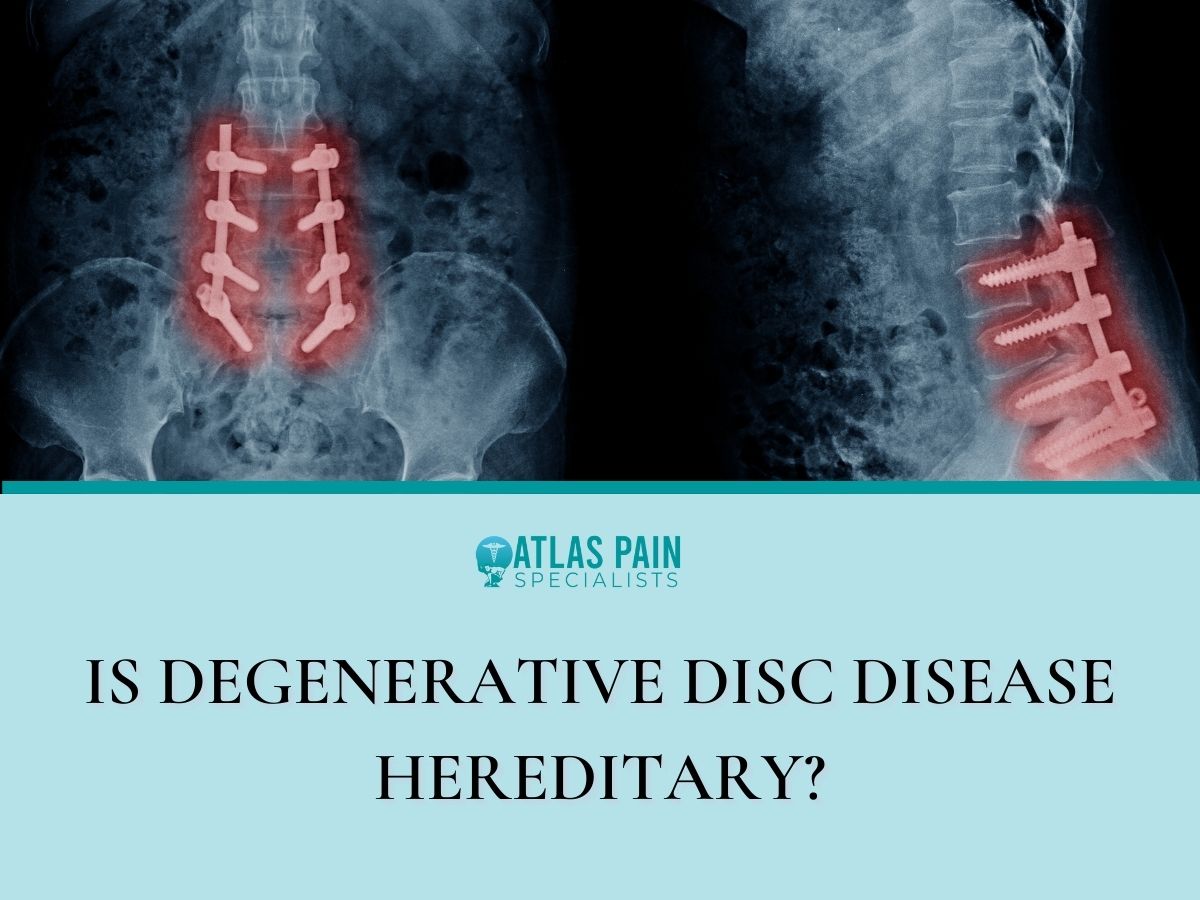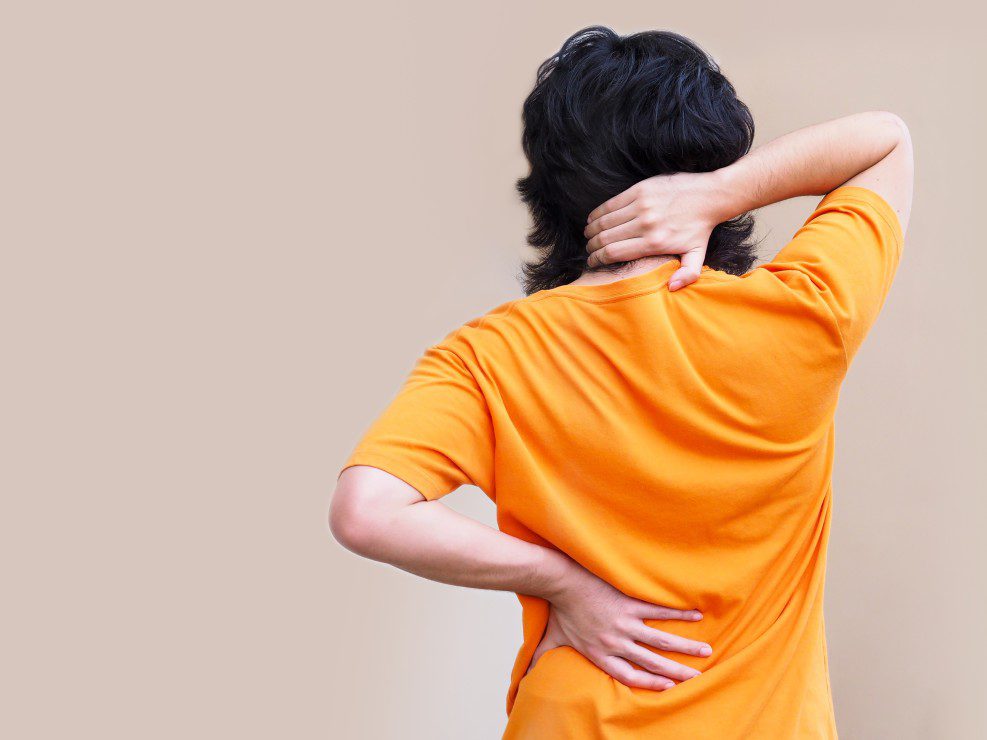

Is Degenerative Disc Disease Hereditary?
Degenerative disc disease is something that raises many questions. To begin with, it's not an illness in the traditional sense; instead, it's a symptom of a damaged disc.
Disc degeneration symptoms may be caused by aging of the spinal discs or by recent trauma to the spine. Back pain is a common symptom as we age because of the strain our bodies are through. After a certain age, disc degeneration is common, although not everyone who has it has back discomfort.
According to some studies, a DDD family member may increase your risk of acquiring a painful back ailment. Is degenerative disc disease hereditary, and if so, what are the risk factors?
What is Degenerative Disc Disease?
Degenerative disc disease is an ailment in which one or more discs between the vertebrae of the spine break down or "degenerate."
While it is considered a sickness, it is not an actual illness but a naturally occurring condition that develops as discs progressively lose flexibility and stop providing an adequate cushion for the spine.
Problems like DDD are commonly referred to as "wear-and-tear" problems since they are related to aging or damage due to an accident.
Is Degenerative Disc Disease Genetic?
Do most people believe that degenerative disc disease is caused by age, but is this really true? Studies have been conducted recently to see whether the illness has a genetic component.
Lumbar disc disease may be hereditary, according to some research. According to the findings, having a degenerative disc in a close family member also increases one's risk of developing it.
Even though the evidence isn't clear, it points to a genetic basis for degenerative lumbar disc degeneration.
According to research, genetics may be linked to how individuals experience pain due to their disease. Even though a pain gene hasn't been uncovered, the previous study has shown that pain tolerance and susceptibility may be inherited.
Common Symptoms of Degenerative Disc Disease

A person's experience with degenerative disc disease may differ from that of another. Some people have no symptoms at all, while others have excruciating discomfort that interferes with their regular routines. The following are some of the more prevalent signs and symptoms:
- Leg muscle weakness that lasts anywhere from a few days to a few months
- Back or neck discomfort that is greater when you sit down
- Severe pain. Walking or running may ease the pain.
- Injuries exacerbated by twisting, bending, or contracting
- Reducing pain by often shifting postures
- Laying on your back relieves some of the discomforts
Causes of Degenerative Disc Disease
Degenerative disc disease is increasingly common as you become older. As you age, your spinal discs may become thinner and less flexible due to a lack of fluid.
Degenerative disc disease is more common among smokers. Cracks or minor rips in the outer layer of a disc may potentially lead to the disc's rupture. Excessive lifting, obesity, and being overweight may also cause the illness.
Degenerative disc disease is more likely to occur in people with illnesses such as osteoarthritis and degenerative disc disease (also known as a ruptured disc).
Lumbar degenerative disc disease-related low back pain is often brought on by one or both of the following factors:
- Inflamed nerves are small and potentially huge, irritated by proteins found in the disc area (the sciatic nerve).
- Movement along the vertebral segment might occur due to abnormal micro-motion instability when the annulus fibrosis (the disc's outer ring) wears out and cannot absorb stress adequately.
- The discomfort from lumbar degenerative disc degeneration gradually diminishes over time rather than worsening.
- In the case of a deteriorated disc, no inflammatory proteins (which might cause pain) are present; therefore, the micro-motion that causes the pain is eliminated, resulting in relief.
- The blood flow to the discs is interrupted when the disc endplates are destroyed, resulting in a shortage of nutrients and oxygen necessary to restore damaged tissues.
- A mechanism known as the degenerative cascade may cause a disc to degenerate rapidly after only one stress or injury. Ten to thirty years are normal for the degenerative cascade, which is characterized by the following cycle:
- Acute pain may result from initial stress or injury, which may be very intense. Stiff and limited mobility may occur following an initial injury or stress to the disc. In many situations, the development of symptoms is not caused by a specific injury.
- After a protracted period of relative instability, the damaged spinal section is finally stabilized. The muscles, ligaments, and facet joints surrounding the disc area progressively adapt to restore spinal stability as the disc height falls. Low back discomfort might be mild or severe at times during this phase.
- Pain and other symptoms usually subside after the spinal section has stabilized.
Risk Factors for Degenerative Disc Disease

The spinal discs are susceptible to the effects on a person's general health and way of life. Degenerative disc disease risk factors include:
- Back or musculoskeletal disease in the family
- Sports, hard lifting, or labor-intensive work may put a lot of stress on the mid or lower back.
- Due to extended sitting and bad posture, the lumbar spinal discs are put under strain.
- Weak core muscles are to blame for the discs' inability to provide enough support.
- Obesity
- The consumption of nicotine by smoking or any other means.
- Discs usually degenerate as we age, although not everyone has pain or noticeable symptoms. When the spine is unstable, muscles are tense, and maybe nerve roots are irritated, symptoms are likely to emerge.
Stages of Degenerative Disc Disease
Volar and discs are two of the spine's major components. Cushioning, support, and flexibility are all provided by the discs, which are located between the vertebrae.
The inner layer of each disc is soft, while the outside layer is hard. Discs may degenerate, thin, and even rupture over time or due to injury.
Degenerative disc disease progresses in phases, as do many other illnesses. The unfavorable symptoms worsen as the phases develop. Pressure on nerves and friction between vertebrae are more likely if a disc is damaged or ruptured.
Stage 1
A chiropractor or other medical professional can identify the first stage of degenerative disc disease, which may go unnoticed by the individual.
Degenerative disc disease may develop when the spine loses its normal curvature. Pressure on the spine may contribute to faster aging of the spine, nerves, joints, and other body parts, even if the pain isn't obvious.
Stage 2
In the second stage, discs begin showing wear and tear. In addition, bone deformations, such as bone spurs, are frequent in these patients.
The curvature of the spine will worsen, and the spinal canal may get smaller. In most cases, it's in Stage 2 that you start to feel any kind of discomfort.
Stage 3
More discomfort and less mobility are hallmarks of the third stage, characterized by more drastic changes in posture and spinal curvature.
Injuries to the nerves and the formation of scar tissue are frequent. The discs are now considerably thinner, leading to even greater bone distortion.
Stage 4
Most people believe the last stage of degenerative disc disease is irreversible at their thinnest or completely gone discs.
Spinal flexibility is severely restricted, and discomfort is often severe. Spinal bones may even fuse if there is substantial damage to the nerves.
What Can Chiropractic Do for Degenerative Disc Disease?
Degenerative disc disease is best treated with chiropractic therapy for many reasons. Chiropractic treatment has fewer adverse effects than prescription drugs and surgery since it is non-invasive and mild.
Early detection of degenerative disc disease means that therapy is more likely to be effective. Regarding degenerative disc disease, chiropractic care might still be beneficial. Chiropractic treatments may include:
Chiropractic Adjustments
Maintaining appropriate spinal alignment is a very effective treatment for degenerative disc disease. A misalignment of the spine, whether through trauma or the wear and tear of daily living, may hasten the degeneration of discs. Adjustments regain alignment.
Spinal Decompression
In addition to modifications, decompression is an essential therapy. The moderate yet strong pressure of spinal decompression is used to re-establish the space between the vertebrae. Space permits blood flow to return, allowing healing to take place.
Degenerative Disc Disease Treatment

Degenerative disc disease can be treated, which is a positive thing. There is no guarantee that these therapies will cure the problem, but they may help alleviate or eliminate discomfort.
These non-surgical techniques may be effective in relieving your symptoms. Sometimes, your doctor may prescribe pain medication, physical therapy, or behavioral changes to manage disc degeneration.
Any of the following symptoms might indicate that you have degenerative disc disease. This does not transmit from generation to generation, so don't worry about it being inherited.
Please see your physician if you need assistance with treating degenerative disc disease.
Based on the degree of the problem and the symptoms the patient is experiencing, a degenerative disc may be treated in various ways. If alternative therapies fail, the invasiveness of the treatment rises to a higher level.
1. Exercise and Physical Therapy
Activities to strengthen the spine region may improve mobility if the discomfort does not prohibit you from moving.
The afflicted discs may be stabilized in this manner. These activities include walking, swimming, cycling, yoga, and pilates.
A physical therapist teaches you how to walk and lift appropriately if you have a degenerative disc. Additional mobility may be gained by wearing a back brace.
2. Medications
Doctors may prescribe a variety of drugs to alleviate symptoms and ease discomfort.
Analgesics such as Tylenol and nonsteroidal anti-inflammatory medications (NSAIDs) may also be used. Injecting steroids into the spine under x-ray guidance is the most common method of administering steroids.
3. Surgery
Surgery is a possibility if other therapies have failed. An artificial disc replacement is one of the most common surgical procedures.
4. Stem Cell Therapy
An injection of stem cells that have the potential to become specialized cells is used in stem cell treatment, which is used to treat degenerative discs. The injection of stem cells facilitates regeneration and healing.
How to Prevent Degenerative Disc Disease
Preventative medicine, as the saying goes, is the best medicine. You can do several things to avoid or at least reduce the progression of degenerative disc conditions, as described in this section.
Exercise often and have a healthy lifestyle. Keep your back flexible with stretching exercises like those found in yoga.
Ensure that your posture and body mechanics are correct. If you're a smoker, try to cut down or stop. Avoid more stress on your spine by decreasing weight if you are overweight.
As you can see, maintaining a healthy lifestyle includes all of these activities.
FAQ
When it comes to disc degeneration, who is most at risk?
You may get degenerative disk disease when the cushioning in your spine starts to wear down. Most people's spines begin to degenerate around the age of 40. People in their 60s and 70s are more likely to be affected.
How old are individuals when they become susceptible to DDD?
Those with degenerative disc disease are often in their 30s or 40s and active. Among this illness's most common signs and symptoms are: Symptoms are exacerbated by sitting down. A three-fold increase in stress is placed on lower back discs while sitting than when standing.
About Dr. Sean Ormond



